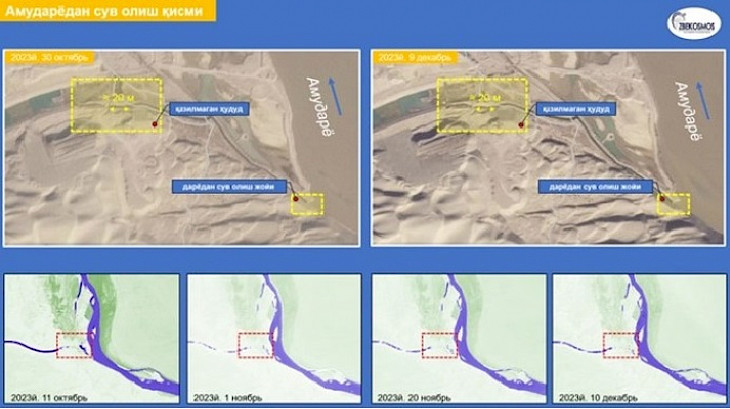The Space Research and Technology Agency at the Ministry of Digital Technologies of Uzbekistan ("Uzbekcosmos") commented on reports of an "accident" on the Kohtepa channel in Afghanistan, as reported by Gazeta.uz.
On December 12, the environmental coalition project "Rivers without Boundaries" reported that a "serious accident" occurred on the irrigation Kohtepa channel, which diverts water from the Amu Darya River, in the neighboring country.
Coalition specialists analyzed satellite images showing that "in the first month after the start of filling the channel with water from the Amu Darya, the walls of the hydraulic structure apparently could not withstand the pressure of the water flow — and a huge volume of water, bursting out of the channel, spread over the entire nearby area."
"The force and volume of the water that burst out of the channel were enough to create a massive spillage 9 km long," noted Alexander Kolotov, coordinator of "Rivers without Boundaries" for Central Asia. "Moreover, recent satellite images show that the area of the spillage is steadily increasing, which may indicate the Taliban's inability or unwillingness to rectify the situation."
"Uzbekcosmos" reported that they studied the reports based on the "retrospective analysis of multispectral satellite images of various spatial resolutions."
The agency stated that, during space monitoring, an increase in groundwater levels was identified on certain sections of the Kohtepa channel since May 2022.
During the construction, temporary obstacles were installed at four sections of the channel, which were completely dismantled on October 10, 2023, after completing the first stage of the work, resulting in the formation of a water flow.
As a result of space monitoring on November 4, a breakthrough of water was recorded at the 75.6 km point on the right bank of the channel. The area of the flooded territory was 19.5 sq. km on November 5, 23.8 sq. km on November 25, and 30.3 sq. km (3030 hectares) on December 13.
"Uzbekcosmos" notes that earthworks for the water intake section from the Amu Darya, where the water is not yet diverted, have not been completed.
In turn, Afghan engineers responsible for the canal construction claim that at the 75.6 km point, water was deliberately diverted to an open area to control the groundwater level.
At the same time, an analysis of high-resolution satellite images on the banks of the channel did not reveal visual signs of intentional excavation (use of special equipment, excavated volume of soil, etc.) to redirect groundwater to an open area.
Moreover, available materials indicate that there is currently a decrease in the groundwater level at the water breach site, and the canal bed is gradually drying up, the statement said.
"Thus, the analyzes conducted show that the information from the international environmental coalition 'Rivers without Boundaries' about the Koht Tepa canal's banks being washed away by the flow of water from the Amu Darya does not correspond to reality. It is confirmed that the leaked water is groundwater," stated Uzbekcosmos.
About the canal:
According to Afghan media, the length of the first section of the canal is 108 km - it starts from the Amu Darya River and reaches the Davlatabad district of Balkh. Its construction took 1.5 years.
The second stage plans to build a canal section 177 km long, passing through the Jowzjan and Faryab provinces. The third stage will include the distribution of small channels to agricultural lands.
The total length of the canal will be 285 km. According to the Afghan authorities' plans, it will irrigate up to 550,000 hectares of land, allowing the cultivation of wheat and other crops.
The project's completion is scheduled for 2028, with an estimated cost of 7 billion Afghanis (approximately $92 million).
Environmentalists note that the Koht Tepa canal will be able to divert up to 15-20% of the entire flow of the Amu Darya. The commissioning of the Rogun HPP on the Vakhsh River in the upper reaches of the Amu Darya is capable of further complicating the water situation in the region, according to the coalition.
CentralasianLIGHT.org
December 15, 2023

